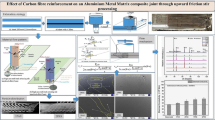Abstract
Composites are light in weight when compared to woods and metals. It consists of two or more distinct phases such as matrix phase and a dispersed phase. Metal matrix composites are expensive and limitations in achieving stiffness and toughness for materials to overcome these limitations, hybrid metal matrix composites (HMMC’s) are fabricated and designed. In recent years hybrid metal matrix composites (HMMC’s) are plays a vital role especially in material science in the field of aerospace, marine, transportation, military and structural applications. Aluminium (Al) based metal matrix hybrid composites are used extensively in the field of automotive industries due to its low density and high strength-to-weight ratio. In the present study, aluminium A356 alloy with different weight fractions (0, 5, 7.5, 10 and 12.5%) of RHA and Fly ash reinforced hybrid composites are fabricated by using double stir casting technique. Determination the effect of the addition of organic (RHA) and in-organic (Fly Ash) reinforcement with aluminium A356 alloy on the physical and mechanical properties such as hardness, density and porosity were studied. FE-SEM, XRD, and EDS were analysed for A356 alloy/RHA-Fly Ash hybrid composite. The size distribution of the matrix alloy and reinforcement particles was measured using particle size. A significant improvement in the mechanical property was observed when adding the reinforcement with as-cast aluminium matrix alloy.
Similar content being viewed by others
References
Rawal SP (2001) Metal-matrix composites for space applications. JOM J Miner Met Mater Soc 53:14–17
Singh J, Chauhan A (2016) Characterization of hybrid aluminum matrix composites for advanced applications–a review. J Mater Res Technol 5:159–169
Dwivedi SP, Sharma S, Mishra RK (2015) Microstructure and mechanical behavior of A356/SiC/Fly-ash hybrid composites produced by electromagnetic stir casting. J Braz Soc Mech Sci Eng 37:57–67
Subrahmanyam APSVR, Narsaraju G, Rao BS (2015) Effect of rice husk ash and fly ash reinforcements on microstructure and mechanical properties of aluminium alloy (AlSi10Mg) Matrix composites. Int J Adv Sci Techn 76:1–8
Bhushan RK, Kumar S, Das S (2013) Fabrication and characterization of 7075 Al alloy reinforced with SiC particulates. Int J Adv Manuf Technol 65:611–624
Hashim J, Looney L, Hashmi MSJ (1999) Metal matrix composites: production by the stir casting method. J Mater Process Technol 92:1–7
Shivkumar S, Wang L, Keller C (1994) Impact properties of A356-T6 alloys. J Mater Eng Perform 3:83–90
Chandrasekhar S, Pramada PN (2006) Rice husk ash as an adsorbent for methylene blue-effect of ashing temperature. Adsorption 12:27–43
Prasad DS, Krishna AR (2012) Tribological properties of A356.2/RHA composites. J Mater Sci Technol 28:367–372
Rohatgi PK (1994) Low-cost, fly-ash-containing aluminum-matrix composites. JOM J Miner Met Mater Soc 46:55–59
Dwivedi SP, Sharma S, Mishra RK (2015) Microstructure and mechanical behavior of A356/SiC/Fly-ash hybrid composites produced by electromagnetic stir casting. J Braz Soc Mech Sci Eng 37:57–67
Alaneme KK, Akintunde IB, Olubambi PA, Adewale TM (2013) Fabrication characteristics and mechanical behaviour of rice husk ash–Alumina reinforced Al-Mg-Si alloy matrix hybrid composites. J Mater Res Technol 2:60–67
Kulkarni SG, Menghani JV, Lal A (2016) Investigation of mechanical properties of fly ash and Al2 O 3 reinforced A356 alloy matrix hybrid composite manufactured by improved stir casting. IJEMS 23:27–36
Anandajothi M, Ramanathan S, Ananthi V, Narayanasamy P (2017) Fabrication and characterization of Ti6Al4V/TiB2-TiC composites by powder metallurgy method. Rare Met 36:806–811
Vanarotti M, Shrishail P, Sridhar BR, Venkateswarlu K, Kori SA (2014) Study of mechanical properties & residual stresses on post wear samples of A356-SiC metal matrix composites. Procedia Mater Sci 5:873–882
Givi AN, Rashid SA, Aziz FNA, Salleh MAM (2010) Assessment of the effects of rice husk ash particle size on strength, water permeability and workability of binary blended concrete. Construct Build Mater 24:2145–2150
Bui DD, Hu J, Stroeven P (2005) Particle size effect on the strength of rice husk ash blended gap-graded Portland cement concrete. Cem Concr Compos 27:357–366
Hwang CL, Huynh TP (2015) Effect of alkali-activator and rice husk ash content on strength development of fly ash and residual rice husk ash-based geopolymers. Construct Build Mater 101 :1–9
Dinaharan I, Kalaiselvan K, Murugan N (2017) Influence of rice husk ash particles on microstructure and tensile behavior of AA6061 aluminum matrix composites produced using friction stir processing. Composites Commun 3:42–46
Sivakumar G, Ananthi V, Ramanathan S (2017) Production and mechanical properties of nano SiC particle reinforced Ti–6Al–4V matrix composite. Trans Nonferrous Metals Soc China 27:82– 90
Amritphale SS, Mishra D, Mudgal M, Chouhan RK, Chandra N (2016) A novel green approach for making hybrid inorganic-organic geopolymeric cementitious material utilizing fly ash and rice husk. J Environ Chem Eng 4:3856–3865
Selvam JDR, Smart DR, Dinaharan I (2013) Microstructure and some mechanical properties of fly ash particulate reinforced AA6061 aluminum alloy composites prepared by compocasting. Mater Des 49:28–34
Liu Y, Zheng L, Li X, Xie S (2009) SEM/EDS and XRD characterization of raw and washed MSWI fly ash sintered at different temperatures. J Hazard Mater 162:161–173
Shoumkova A, Stoyanova V (2013) SEM–EDX and XRD characterization of zeolite NaA, synthesized from rice husk and aluminium scrap by different procedures for preparation of the initial hydrogel. J Porous Mater 20:249–255
Acknowledgments
The authors wish to thank Professor Dr. N.Selvakumar, Director, ‘Nano centre’, Mepco Schlenk Engineering College, Sivakasi, Tamil nadu, India rendered the support for the fabrication of Hybrid Composites. The authors also wish to acknowledge for the extended facilities by ‘Centralised Instrumentation Science Laboratory’, the Department of Physics, Annamalai University.
Author information
Authors and Affiliations
Corresponding author
Rights and permissions
About this article
Cite this article
Vinod, B., Ramanathan, S., Ananthi, V. et al. Fabrication and Characterization of Organic and In-Organic Reinforced A356 Aluminium Matrix Hybrid Composite by Improved Double-Stir Casting. Silicon 11, 817–829 (2019). https://doi.org/10.1007/s12633-018-9881-5
Received:
Accepted:
Published:
Issue Date:
DOI: https://doi.org/10.1007/s12633-018-9881-5




